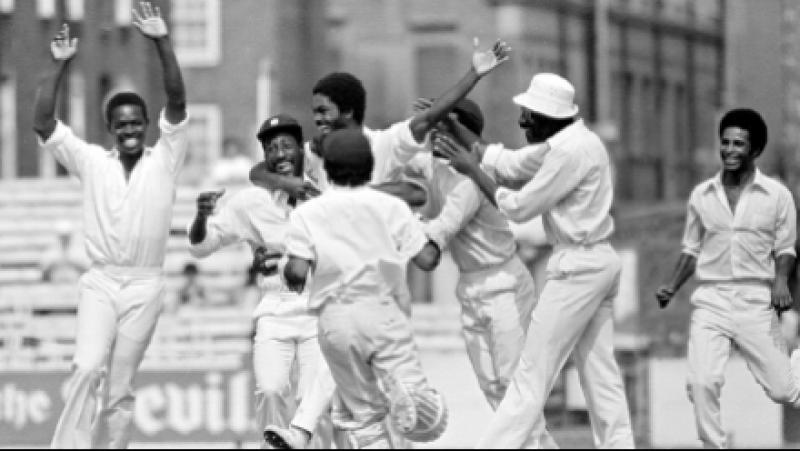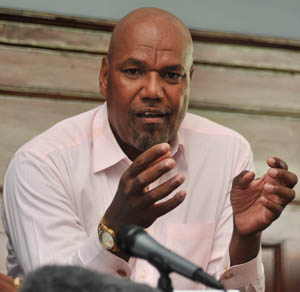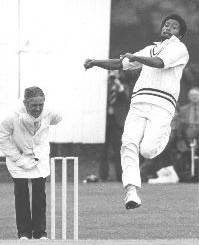Fire in Babylon | reviews, news & interviews
Fire in Babylon
Fire in Babylon
Was this the greatest cricket team of all time? The Windies in their pomp

To the relief of many an international batsman, there has never been anything to rival the stupendous West Indies teams which bestrode Planet Cricket with intimidating ferocity from the late Seventies into the Nineties. Fire in Babylon is the story of the side that Clive Lloyd built, and the way it became a formidable socio-political force in the Caribbean as well as a sporting global superpower.
The interlocking themes of sport, colonialism and the struggle against racial prejudice add up to a celluloid Molotov cocktail, and director Stevan Riley and producers John Battsek and Charles Steel have hurled it with unerring accuracy. They've pruned the narrative down to its core, and avoided cluttering it with distracting nuances or shades of grey. As they tell it, this was the best cricket team of all time, it wrote the book on massed batting and bowling firepower, and it gave the fragmented island nations of the West Indies a sense of cohesive identity for the first time in their history. Contributions from Bunny Wailer, author and teacher Frank I, historian Hilary Beckles and others paint in some social background, while the reggae and calypso soundtrack keeps up its own running commentary.
The story stretches back to the British colonial era, and the key moment in the 1950s when Frank Worrell became the first black West Indies captain. But the side couldn't shake off typecasting about their jolly "Calypso Cricket", which earned them patronising ticker-tape send-offs from Australia after they'd played exuberantly and lost.
 Though the Windies always saved up extra ferocity for playing against England, their Caribbean colonisers, the film gives the Australians backhanded credit for launching their era of pulverising supremacy. When West Indies went Down Under in 1975, in the process of rebuilding under new captain Clive Lloyd, they were rocked to the core not only by the torrid fast bowling of Dennis Lillee and Jeff Thomson ("He was a mean man," batsman Desmond Haynes says of Thomson), but by the hostility and racist abuse from opposing players and spectators. Young fast bowler Michael Holding was one of several players who were pushed to the brink of quitting Test cricket altogether (Colin Croft today, pictured above).
Though the Windies always saved up extra ferocity for playing against England, their Caribbean colonisers, the film gives the Australians backhanded credit for launching their era of pulverising supremacy. When West Indies went Down Under in 1975, in the process of rebuilding under new captain Clive Lloyd, they were rocked to the core not only by the torrid fast bowling of Dennis Lillee and Jeff Thomson ("He was a mean man," batsman Desmond Haynes says of Thomson), but by the hostility and racist abuse from opposing players and spectators. Young fast bowler Michael Holding was one of several players who were pushed to the brink of quitting Test cricket altogether (Colin Croft today, pictured above).
Lloyd vowed to fight fire with fire, and he combed the Caribbean for up-and-coming fast bowlers. Australia had two, but the new-look Windies emerged with four, and came to England in 1976, raring to demolish the old enemy. England skipper Tony Greig, born in South Africa, made his fateful comment that he wanted to "make the West Indies grovel", which lit the touchpaper on a series which West Indies won 3-0. It would get much worse, as England would discover in 1984, when David Gower's side crashed to a 5-0 "blackwash". Australia's comeuppance was next on the schedule, with fast bowler Colin Croft recalling with relish how the formerly arrogant Aussies were terrorised into submission.
 Thirty years on, cricket is a different beast with its trainers, nutritionists, sports psychologists and Twenty20 tournaments, but it's hard to picture any side from any era beating a Windies packed with all-time greats like Andy Roberts (pictured left), Joel Garner, Michael Holding, Viv Richards, Gordon Greenidge and Clive Lloyd. The film is a vivid and sometimes emotional reminder of their prowess, but it also reopens some old scars. The undertones of racial warfare were never far from the surface, while some veteran West Indies players still resent the way they were portrayed as terrorists or would-be murderers by other cricketing countries as soon as they started to win on a regular basis.
Thirty years on, cricket is a different beast with its trainers, nutritionists, sports psychologists and Twenty20 tournaments, but it's hard to picture any side from any era beating a Windies packed with all-time greats like Andy Roberts (pictured left), Joel Garner, Michael Holding, Viv Richards, Gordon Greenidge and Clive Lloyd. The film is a vivid and sometimes emotional reminder of their prowess, but it also reopens some old scars. The undertones of racial warfare were never far from the surface, while some veteran West Indies players still resent the way they were portrayed as terrorists or would-be murderers by other cricketing countries as soon as they started to win on a regular basis.
 It's certainly a corrective to any lingering suggestions that politics and sport don't mix. The West Indies team was fuelled by notions of cultural pride and resistance to oppression - "one people, one nation, one vision", as Clive Lloyd put it - and its glory years coincided with the rise of other Caribbean icons like Bob Marley and Jimmy Cliff. When some West Indies players toured apartheid South Africa in the early Eighties, enjoying the status of "honorary whites" for the occasion, they were met with disgust and ostracism when they returned to the Caribbean. Interviews with Michael Holding and the imperious Viv Richards resonate with righteous horror at the idea of consorting with the apartheid regime (pictured above, left to right, Messrs Croft, Garner, Greenidge and Holding at the Oval last week).
It's certainly a corrective to any lingering suggestions that politics and sport don't mix. The West Indies team was fuelled by notions of cultural pride and resistance to oppression - "one people, one nation, one vision", as Clive Lloyd put it - and its glory years coincided with the rise of other Caribbean icons like Bob Marley and Jimmy Cliff. When some West Indies players toured apartheid South Africa in the early Eighties, enjoying the status of "honorary whites" for the occasion, they were met with disgust and ostracism when they returned to the Caribbean. Interviews with Michael Holding and the imperious Viv Richards resonate with righteous horror at the idea of consorting with the apartheid regime (pictured above, left to right, Messrs Croft, Garner, Greenidge and Holding at the Oval last week).
It's a source of sadness to the Windies veterans that there are already Caribbean generations who know little or nothing about their achievements. Fire in Babylon, they hope, might help to turn that around.
Watch the trailer for Fire in Babylon
Share this article
The future of Arts Journalism
You can stop theartsdesk.com closing!
We urgently need financing to survive. Our fundraising drive has thus far raised £49,000 but we need to reach £100,000 or we will be forced to close. Please contribute here: https://gofund.me/c3f6033d
And if you can forward this information to anyone who might assist, we’d be grateful.

Subscribe to theartsdesk.com
Thank you for continuing to read our work on theartsdesk.com. For unlimited access to every article in its entirety, including our archive of more than 15,000 pieces, we're asking for £5 per month or £40 per year. We feel it's a very good deal, and hope you do too.
To take a subscription now simply click here.
And if you're looking for that extra gift for a friend or family member, why not treat them to a theartsdesk.com gift subscription?
more Film
 Can I get a Witness? review - time to die before you get old
Ann Marie Fleming directs Sandra Oh in dystopian fantasy that fails to ignite
Can I get a Witness? review - time to die before you get old
Ann Marie Fleming directs Sandra Oh in dystopian fantasy that fails to ignite
 Happyend review - the kids are never alright
In this futuristic blackboard jungle everything is a bit too manicured
Happyend review - the kids are never alright
In this futuristic blackboard jungle everything is a bit too manicured
 Robert Redford (1936-2025)
The star was more admired within the screen trade than by the critics
Robert Redford (1936-2025)
The star was more admired within the screen trade than by the critics
 Blu-ray: The Sons of Great Bear
DEFA's first 'Red Western': a revisionist take on colonial expansion
Blu-ray: The Sons of Great Bear
DEFA's first 'Red Western': a revisionist take on colonial expansion
 Spinal Tap II: The End Continues review - comedy rock band fails to revive past glories
Belated satirical sequel runs out of gas
Spinal Tap II: The End Continues review - comedy rock band fails to revive past glories
Belated satirical sequel runs out of gas
 Downton Abbey: The Grand Finale review - an attemptedly elegiac final chapter haunted by its past
Noel Coward is a welcome visitor to the insular world of the hit series
Downton Abbey: The Grand Finale review - an attemptedly elegiac final chapter haunted by its past
Noel Coward is a welcome visitor to the insular world of the hit series
 Islands review - sunshine noir serves an ace
Sam Riley is the holiday resort tennis pro in over his head
Islands review - sunshine noir serves an ace
Sam Riley is the holiday resort tennis pro in over his head
 theartsdesk Q&A: actor Sam Riley on playing a washed-up loner in the thriller 'Islands'
The actor discusses his love of self-destructive characters and the problem with fame
theartsdesk Q&A: actor Sam Riley on playing a washed-up loner in the thriller 'Islands'
The actor discusses his love of self-destructive characters and the problem with fame
 Honey Don’t! review - film noir in the bright sun
A Coen brother with a blood-simple gumshoe caper
Honey Don’t! review - film noir in the bright sun
A Coen brother with a blood-simple gumshoe caper
 The Courageous review - Ophélia Kolb excels as a single mother on the edge
Jasmin Gordon's directorial debut features strong performances but leaves too much unexplained
The Courageous review - Ophélia Kolb excels as a single mother on the edge
Jasmin Gordon's directorial debut features strong performances but leaves too much unexplained
 Blu-ray: The Graduate
Post #MeToo, can Mike Nichols' second feature still lay claim to Classic Film status?
Blu-ray: The Graduate
Post #MeToo, can Mike Nichols' second feature still lay claim to Classic Film status?

Add comment